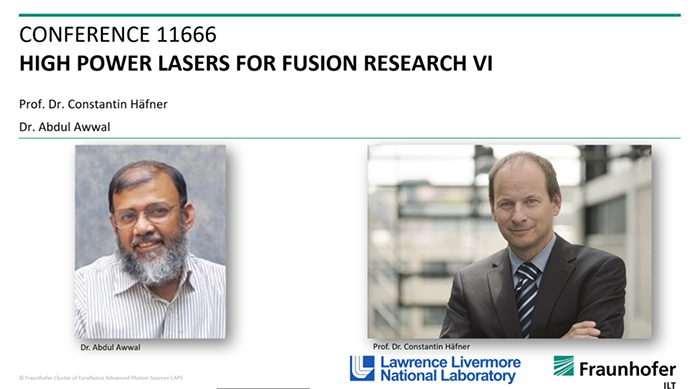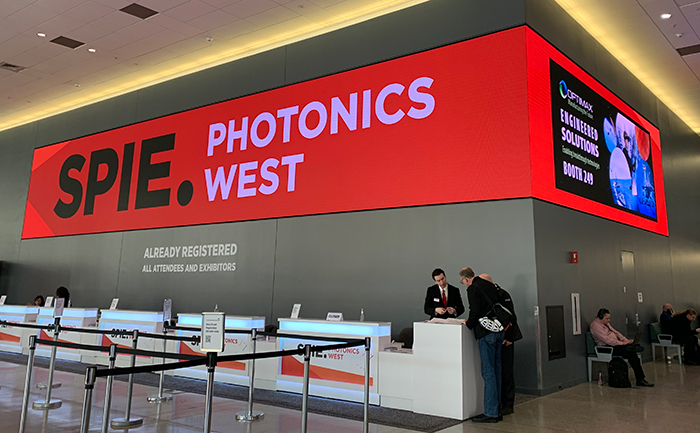Progress at NIF, Other High Power Laser Facilities Outlined at Photonics West
May 5, 2021
 Abdul Awwal of LLNL and Constantin Haefner of the Fraunhofer Institute for Laser Technology co-chaired this year’s virtual High Power Lasers for Fusion Research VI conference.
Abdul Awwal of LLNL and Constantin Haefner of the Fraunhofer Institute for Laser Technology co-chaired this year’s virtual High Power Lasers for Fusion Research VI conference. At a recent virtual conference, representatives from NIF and other high-power laser facilities around the world reported on continued progress of fusion research despite the added challenges of the past year.
Attendees of the High Power Lasers for Fusion Research VI conference in March heard updates about NIF, France’s Laser Mégajoule, the LaserNetUS network of high-power lasers, and advancements in diagnostics and machine learning applications.
“Recent progress has allowed us to close the gap on fusion ignition and make big strides toward this goal,” Jean‑Michel Di Nicola, NIF’s chief engineer for laser systems, told the online attendees. “The ignition program focuses on understanding and increasing the compression in the hotspots, increasing the coupling of laser energy to the capsule, and improving predictive capability through better simulation and theory. Progress on all of the above have fueled the recent performance increases.”
The fusion research conference is held every two years as part of the lasers portion of Photonics West, the annual International Society for Optical Engineering (SPIE) convention. In past years, Photonics West filled San Francisco’s Moscone Convention Center, but this year’s edition was held online due to COVID-19 restrictions.
The conference is co-chaired by LLNL engineer Abdul Awwal and Constantin Haefner, managing director of Germany’s Fraunhofer Institute for Laser Technology and former NIF program director for Advanced Photon Technologies (APT).
Di Nicola delivered an update on NIF, the world’s largest and most energetic laser, by noting a number of performance-improving projects, such as modernization of the 15-year-old master oscillator room (MOR) where laser pulses are first generated. He also outlined the use of updated computer codes for physics simulations with VBL++ (Virtual Beam Line) now executed on Livermore computing clusters, and how NIF is recommissioning and enhancing a retired precision diagnostic system (PDS) to better characterize laser beams.
“In summary, 2020 was a challenging year, but we obtained exciting results with record fusion yields,” Di Nicola said. “We embarked on a multi-year program to mitigate obsolescence, provide new capabilities, and improve performance 3x to 5x on key metrics for some of the subsystems of the laser.
“We also demonstrated with various campaigns and simulations that NIF has the potential for higher energy and power performance,” he added. “And last but not least, we deployed advanced beam characterization diagnostics, executed laser physics campaigns, and enhanced our laser modeling codes to understand the true NIF performance limits.”
HED Science
Awwal gave a presentation on one of the alignment loops of the Optical Thompson Scattering Laser (OTSL), a new diagnostic tool to measure plasma conditions inside hohlraums during inertial confinement fusion (ICF) implosions and other high-energy-density (HED) systems (see “A Challenging New Tool to Diagnose Hohlraum Plasma).
 The conference is part of Photonics West, which in 2020 was held in person in San Francisco. Credit: Benny Evangelista
The conference is part of Photonics West, which in 2020 was held in person in San Francisco. Credit: Benny EvangelistaTammy Ma, APT program element leader for High-Intensity Laser High Energy Density (HED) Science, discussed developments in next-generation high-repetition-rate laser facilities around the world.
“Lawrence Livermore is moving HED experimental physics to high repetition rate,” Ma said. “High-rep-rate laser science is an opportunity to accelerate the rate of knowledge acquisition in HED.”
She said that not only means that “we can shoot a laser very fast and take data very fast,” but that it requires “a full ecosystem that includes feedback control loops for the laser, experiment, and simulations to optimize the entire system in real time. To make this vision a reality, we do have to leverage a number of Livermore competencies and this includes a suite of high rep-rate diagnostics, automated analysis, and active feedback that we are developing.”
LLNL also wants to leverage its expertise “on novel cognitive simulation techniques to push the forefront of scientific machine learning,” Ma added, “and combine our HED experimental expertise with advanced codes and machine learning.”
Diagnostics
Graduate scholar Raspberry Simpson gave a talk about how she and fellow members of the High Intensity Laser HED Group at LLNL are working on diagnostics and machine-learning tools to take advantage of data acquired from those high-rep-rate lasers. The goal, she said, was “to aid in rapid learning on these short-pulse-laser ion acceleration experiments.”
Postdoctoral researcher Blagoje Djordjevic described a parameter-space exploration of short-pulse, laser-driven ion acceleration using an ensemble of thousands of simulations and neural networks. He showed how, by using surrogate models and transfer learning, he could extract important physical information from experimental data that is difficult to observe directly.
Staff scientist Félicie Albert also presented an overview of LaserNetUS, a network of laser facilities working to help restore the U.S.’s dominant position in high-intensity laser research. The network, which includes LLNL’s Jupiter Laser Facility (JLF), is chaired by Albert, who noted support from a number of recent reports from influential scientific community organizations.
“All of these agree that LaserNetUS should be supported and continue to grow,” Albert said (see "Reports Recommend Stepped-Up U.S. Investment in Fusion Energy").
Also presenting at this year’s Photonics West, in the Ultrafast Phenomena and Nanophotonics XXV conference, was graduate scholar Elizabeth Grace. She spoke about a novel single-shot complete spatiotemporal measurement using a diagnostic device called the STRIPED FISH (Spatially and Temporally Resolved Intensity and Phase Evaluation Device: Full Information from a Single Hologram). These measurements were demonstrated on a high-power (greater than 0.1 terawatt) laser for the first time at JLF’s COMET laser.
Awwal said the conference was just as important for NIF as in past years, even though it was held online.
“This year, we had very good representation from NIF at the conference,” Awwal said. “In a live conference, the NIF talks always bring in bigger crowds. It is important for NIF and other facilities to keep the scientific community abreast of the new and exciting developments in the field.”
—Benny Evangelista
Follow us on Twitter: @lasers_llnl



